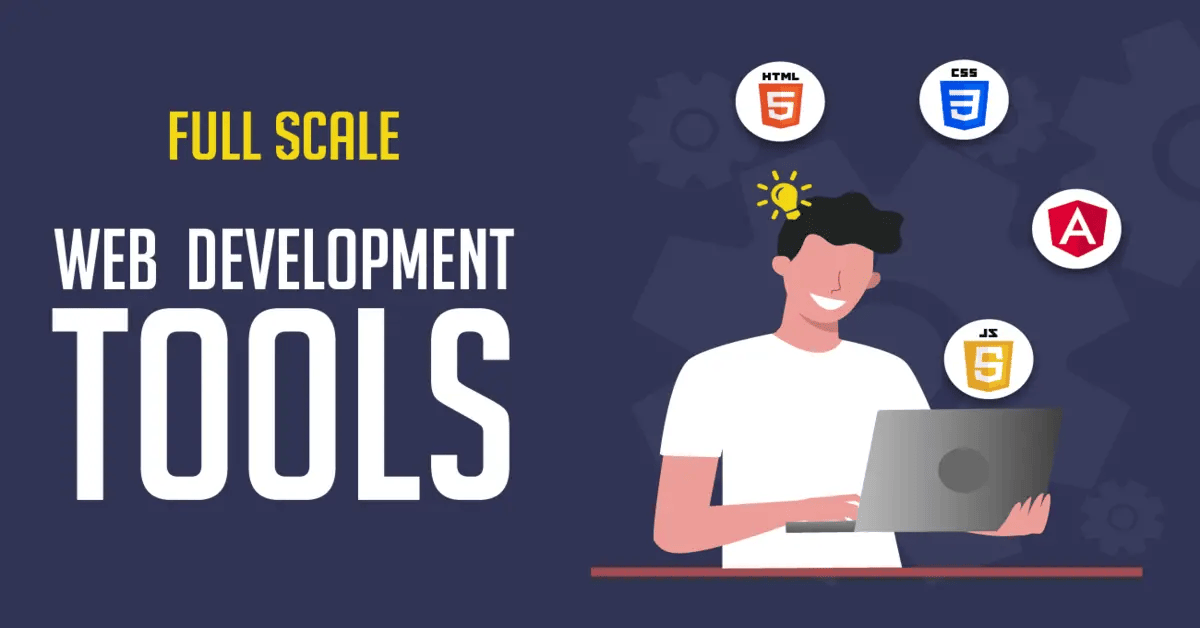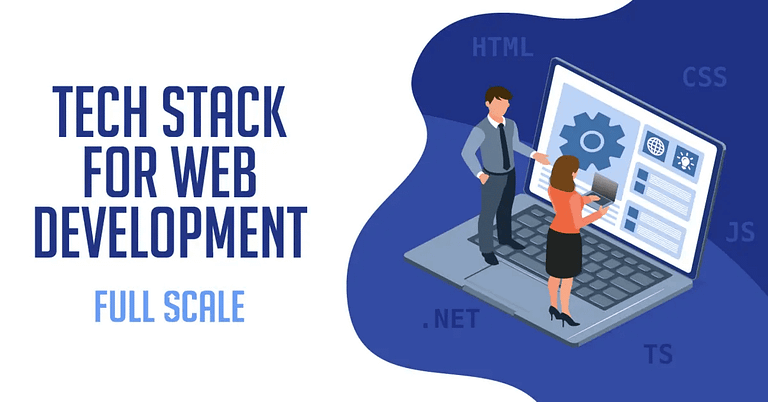Last Updated on 2024-10-11
Learn about the latest tech stack for web development. Get some tips on how to choose the tech stack for your web development project.
Web development is a complex process that requires several tools to ensure its success. A web development tech stack can make or break the performance of an application. In this entry, we’ll study the most popular tech stack for web development and compare their strengths and weaknesses.
What Is A Tech Stack for Web Development?
A tech stack is a collection of technologies that a software team uses to create a web or mobile application. It is made up of programming languages, frameworks, libraries, patterns, servers, UI/UX solutions, software, and tools that its developers employ. A tech stack for web development is a combination of technologies tailored for web development.
Building a web application includes two main components. One is available to the client (frontend) and is responsible for the user interface, while the other (backend) is responsible for the customer’s experience.

Top Tech Stack for Web Development
Now that we know what a web development tech stack is, it’s time to learn more about the most used tech stack for web development. Here are the most popular web tech stacks of 2023:
1. MEAN, MERN, MEVN
MEAN is a JavaScript software stack that is free and open source for creating dynamic webpages and web apps. It comprises MongoDB, Express.js, Angular, and Node.js and may be used to create complicated mobile and responsive web apps.
The MEAN stack support programs are all written in JavaScript. Due to its numerous advantages, experts see MEAN technology as the finest for web development. One of the advantages of using MEAN is it allows for easy scalability and real-time updates. It also has an active support community to draw information from.
On the downside, it’s not very flexible and can be difficult to set up and configure. Web developers also find it challenging to learn. Nonetheless, it is a tried-and-tested web development tech stack and offers a lot of great potential for projects.
MERN and MEVN
Other variants of the MEAN tech stack are MERN and MEVN. MERN (MongoDB, Express, React/Redux, Node.js) employs ReactJS in front-end development and NodeJS in back-end development, and it is beneficial for creating high-end single-page applications such as the Plaid app. It is ideal for creating large-scale apps with its flexible and modular structure.
MEVN (MongoDB, Express, Vue, Node) is a JavaScript software development stack that is open source and has emerged as a new and emerging way to construct powerful and dynamic online apps. Furthermore, its software components can be utilized to design frontend and backend development and increase the functioning of your website or app.
2. PERN
PostgreSQL, Express, React, and Node.js make up the PERN tech stack for web development. You can also create a full-stack web application with CRUD operations by combining these technologies. PostgreSQL is gaining popularity because it provides extensive support for NoSQL features, as well as transactional and standard compliance. It is written in the C programming language.
PostgreSQL is a robust, open-source object-relational database management system (ORDBMS) with an emphasis on extensibility and standards compliance. It employs and extends the SQL language, as well as several capabilities that safely store and handle the most complex data workloads.
3. LAMP
When it comes to time-tested web development stacks, LAMP would be a great choice. LAMP stands for MySQL (Relational Database Management), Linux (Operating System), PHP (Programming Language), and Apache (HTTP server). It is open-source and free to use. The stack works well on all operating systems. It empowers performance, cost-effectiveness, and flexibility in web development.
Additionally, its components can be swapped out or changed within the same stack. LAMP currently refers to a generic software stack approach with mostly interchangeable components. However, it does encounter scalability issues due to Apache and MySQL limitations. Linux is also a complex system to navigate.
4. Flutter
Flutter is a ground-breaking web stack for cross-platform development. Dart, the Flutter engine, the Foundation Library, and design-specific widgets are among its main components. It eliminates the need to sacrifice speed when creating user interfaces, adding new features, or resolving faults.
In creating software or an application with Flutter, it is critical to use consistent software. To save development time and coordinate resources, the backend should be built with technologies that complement one another.
5. Ruby on Rails
Ruby on Rails (RoR) is a dynamic, open-source programming language. It’s developer-friendly, making it easy for the team to design lightweight apps that boost flexibility.
The RoR tech stack collaborates with HTML, CSS, and JavaScript to create interactive user interfaces and XML or JSON to convey data. It also permits the use of pre-defined frameworks for web pages and database management. It also provides a detailed error log to developers, allowing them to create bug-free programs.
Finding Developers and the Best Tech Stack for Web Development
Overall, the success of software development primarily relies on your team’s talent and experience. With the continuous IT talent scarcity, hiring full-stack developers might be difficult. Small and large firms alike are having difficulty filling talent gaps, particularly with initiatives that need the usage of certain technologies.
Fortunately, there are new methods to broaden your reach of recruiting. Full Scale, for example, assists organizations in expanding their search offshore and provides services for hiring and managing professionals abroad. Consider outsourcing with Full Scale if you want to locate employees with the right talent and expertise for your project.
Build Your Software Development Team with Full Scale
If you’re not familiar with software development, leave it to the professionals. A team of skilled web developers can make the most of a technology stack to create top-tier online apps with exceptional design and functionality.
Full Scale hires web developers through our rigorous screening process. Our role is to ensure that clients will find applicants who can meet all their project requirements. Visit our website to begin your journey toward creating the most remarkable software of your dreams. It only takes a few minutes to navigate our client dashboard to find the particular sort of software development resource you desire.
Let Full Scale Help You Today

Matt Watson is a serial tech entrepreneur who has started four companies and had a nine-figure exit. He was the founder and CTO of VinSolutions, the #1 CRM software used in today’s automotive industry. He has over twenty years of experience working as a tech CTO and building cutting-edge SaaS solutions.
As the CEO of Full Scale, he has helped over 100 tech companies build their software services and development teams. Full Scale specializes in helping tech companies grow by augmenting their in-house teams with software development talent from the Philippines.
Matt hosts Startup Hustle, a top podcast about entrepreneurship with over 6 million downloads. He has a wealth of knowledge about startups and business from his personal experience and from interviewing hundreds of other entrepreneurs.





